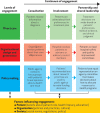From tokenism to empowerment: progressing patient and public involvement in healthcare improvement
- PMID: 26993640
- PMCID: PMC4975844
- DOI: 10.1136/bmjqs-2015-004839
From tokenism to empowerment: progressing patient and public involvement in healthcare improvement
Abstract
Background: There have been repeated calls to better involve patients and the public and to place them at the centre of healthcare. Serious clinical and service failings in the UK and internationally increase the urgency and importance of addressing this problem. Despite this supportive policy context, progress to achieve greater involvement is patchy and slow and often concentrated at the lowest levels of involvement.
Methods: A selective narrative literature search was guided by the authors' broad expertise, covering a range of disciplines across health and social care, policy and research. Published systematic literature reviews were used to identify relevant authors and publications. Google and hand searches of journal articles and reference lists and reports augmented identification of recent evidence.
Results: Patients and the wider public can be involved at most stages of healthcare, and this can have a number of benefits. Uncertainty persists about why and how to do involvement well and evaluate its impact, how to involve and support a diversity of individuals, and in ways that allow them to work in partnership to genuinely influence decision-making. This exposes patient and public involvement (PPI) to criticisms of exclusivity and tokenism.
Conclusions: Current models of PPI are too narrow, and few organisations mention empowerment or address equality and diversity in their involvement strategies. These aspects of involvement should receive greater attention, as well as the adoption of models and frameworks that enable power and decision-making to be shared more equitably with patients and the public in designing, planning and co-producing healthcare.
Keywords: Health policy; Healthcare quality improvement; Patient-centred care.
Published by the BMJ Publishing Group Limited. For permission to use (where not already granted under a licence) please go to http://www.bmj.com/company/products-services/rights-and-licensing/
Figures

Comment in
-
At a crossroads? Key challenges and future opportunities for patient involvement in patient safety.BMJ Qual Saf. 2016 Aug;25(8):565-8. doi: 10.1136/bmjqs-2016-005476. Epub 2016 Jun 22. BMJ Qual Saf. 2016. PMID: 27334867 No abstract available.
References
-
- Bristol Royal Infirmary Inquiry. The Report of the Public Inquiry into Children's Heart surgery at the Bristol Royal Infirmary 1984–1995. London: HMSO, 2001.
-
- Francis R. Report of the Mid Staffordshire NHS Foundation Trust Public Inquiry. London: Stationery Office, 2013.
-
- Kohn LT, Corrigan JM, Donaldson MS. To err is human: building a safer health system. Washington: National Academies Press, 1999. - PubMed
-
- WHO. World Alliance for Patient Safety forward programme. Geneva: World Health Organization, 2008. –2009.
MeSH terms
LinkOut - more resources
Full Text Sources
Other Literature Sources
